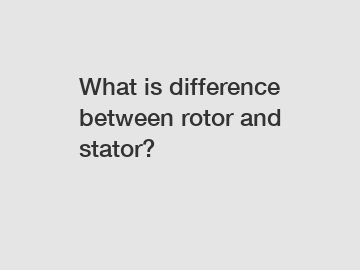What is difference between rotor and stator?
Have you ever heard the terms "rotor" and "stator" when discussing electrical machinery or motors? If you're not quite sure what these terms mean or how they differ from each other, don't worry – we've got you covered! In this article, we'll break down the key differences between a rotor and a stator in simple terms.
What is a Rotor?
Let's start by looking at the rotor. The rotor is the moving part of an electrical machine, such as a motor or generator. It is typically located inside the stator and is responsible for converting electrical energy into mechanical energy. Think of the rotor as the engine of the motor – it's what drives the movement of the machine.

What is a Stator?
Now, let's move on to the stator. The stator is the stationary part of an electrical machine. It is usually made up of coils of wire that are wound around an iron core. The stator's primary function is to generate a magnetic field that interacts with the rotor to produce the desired mechanical output.
Key Differences Between a Rotor and a Stator.
1. Position.
One of the main differences between a rotor and a stator is their position within an electrical machine. The rotor is the moving part, while the stator remains stationary.
2. Function.
The rotor is responsible for converting electrical energy into mechanical energy and driving the movement of the machine. On the other hand, the stator generates a magnetic field that interacts with the rotor to produce mechanical output.
3. Design.
The design of a rotor and a stator also differs. The rotor typically consists of a shaft and conductors that produce the mechanical movement, while the stator is made up of coils of wire wound around an iron core to generate the magnetic field.
4. Operation.
In terms of operation, the rotor rotates within the stator, creating a magnetic field that produces mechanical output. The stator, on the other hand, remains stationary and provides the necessary magnetic field for the rotor to interact with.
Final Thoughts.
In summary, the rotor and stator are essential components of electrical machines such as motors and generators. While the rotor is the moving part responsible for converting electrical energy into mechanical energy, the stator is the stationary part that generates a magnetic field to interact with the rotor. Understanding the differences between a rotor and a stator can help you appreciate how electrical machinery works and how different components play a crucial role in its operation.
If you have any further questions about rotors, stators, or any other electrical components, feel free to contact us. We are a leading supplier of high-quality electrical machinery parts and would be happy to assist you with any inquiries you may have.
For more custom stamped stator core for motor, electric motor plastic moulding stator, Epoxy Coating Rotor for motor coreinformation, please contact us. We will provide professional answers.
167
0
0


Comments
All Comments (0)